Woodpeckers are fascinating birds known for their distinctive drumming sounds and impressive ability to excavate holes in trees. While these birds play a crucial role in ecosystems, their behavior can sometimes pose challenges for homeowners. In this blog, we will explore woodpeckers and provide tips for homeowners to understand and manage their impact effectively.
Understanding Woodpecker Behavior: Woodpeckers drum on surfaces, including trees and houses, primarily for communication, attracting mates, and establishing territory. However, their drumming can cause damage to wooden structures, including siding, eaves, and fascia boards. Understanding their behavior can help homeowners develop appropriate strategies for coexistence.
Deterrent Techniques: Implementing deterrent techniques can discourage woodpeckers from damaging your property. Consider installing reflective objects, such as aluminum foil strips or wind chimes, near the affected areas to create visual and auditory distractions. Covering vulnerable surfaces with mesh or netting can also deter woodpeckers from accessing them.
Providing Alternative Habitats: Woodpeckers are attracted to insect-rich environments. By providing alternative food sources, such as suet feeders or insect-attracting plants, homeowners can divert woodpeckers’ attention away from their property. Creating nesting sites, such as birdhouses with suitable dimensions and entrance hole sizes, can also encourage woodpeckers to nest elsewhere.
Protective Measures: For long-term prevention, homeowners can explore protective measures such as installing woodpecker deterrent products. These products include specialized siding or wrap materials designed to reduce the impact of woodpecker drumming, providing a physical barrier between the birds and the structure.
Legal Considerations: It is important to note that woodpeckers are protected by federal and state laws in many countries. It is illegal to harm or disturb these birds or their nests. Therefore, it is essential to focus on non-lethal and humane methods when managing woodpecker impact. While woodpeckers can present challenges for homeowners, understanding their behavior and implementing appropriate management strategies can help mitigate their impact. By employing deterrent techniques, providing alternative habitats, and considering protective measures, homeowners can coexist with these fascinating birds while preserving the integrity of their property. Remember to always consider the legal and ethical aspects of managing woodpeckers and consult with local wildlife authorities for additional guidance.

